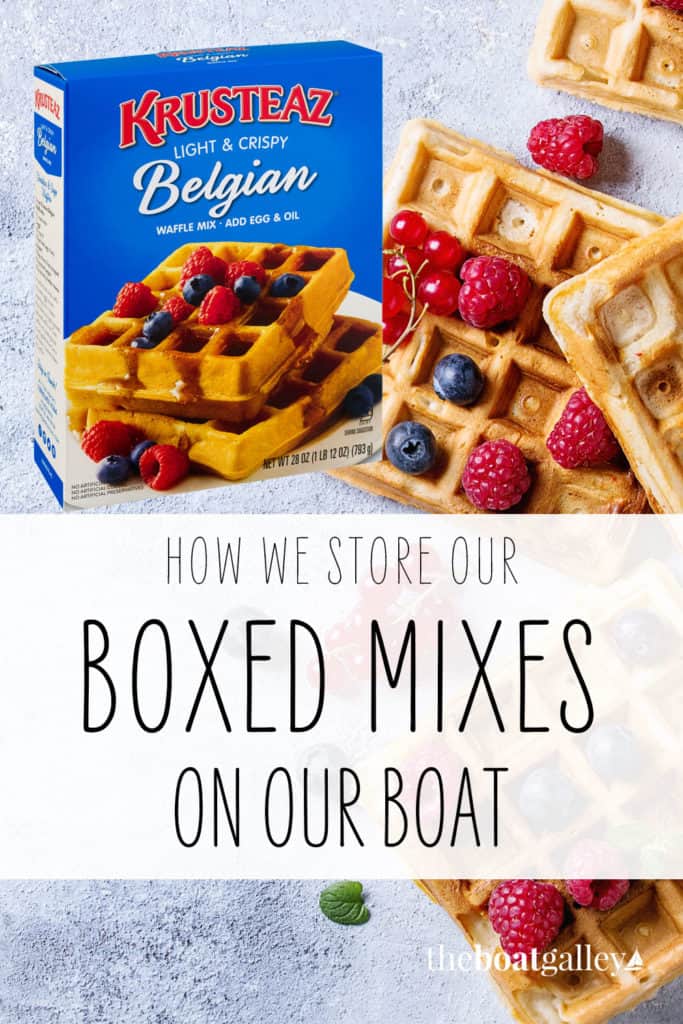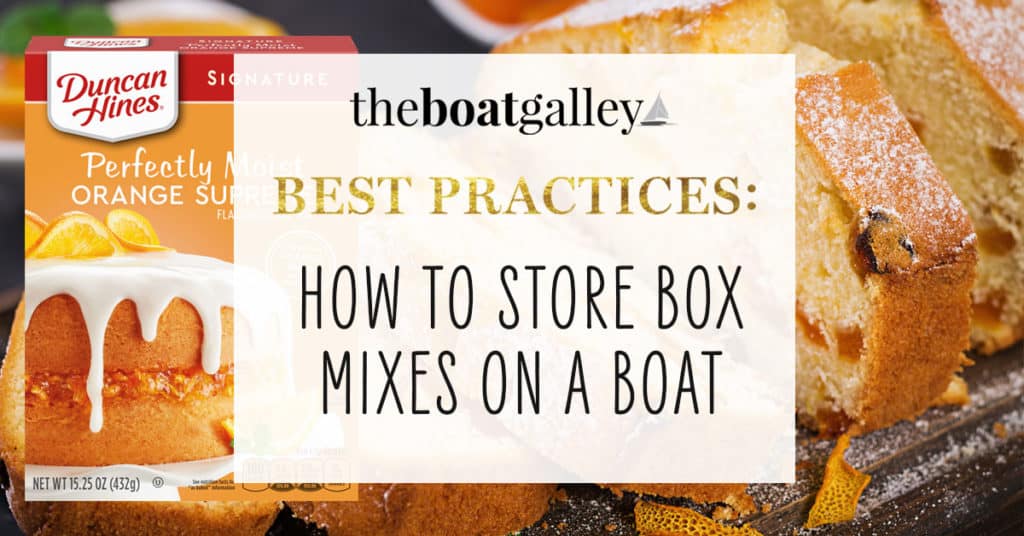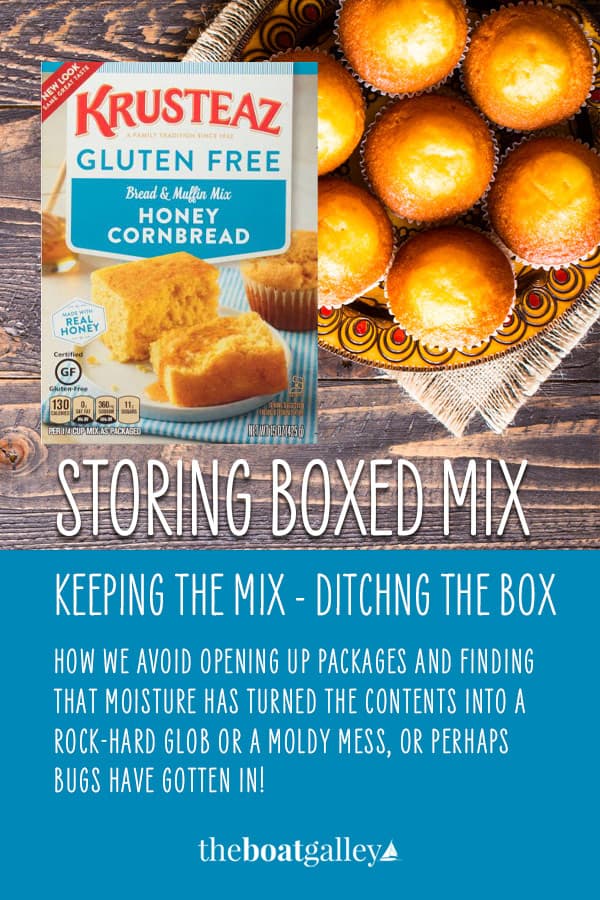
Box mixes are easy and convenient and almost a staple. But when you’re living without heat or airconditioning, how do you store box mixes so that they are still good when you want to use them?
It’s really not so wonderful to open up a package and discover that moisture has turned the contents into a rock-hard glob or a moldy mess, or perhaps bugs have gotten in.
When we began cruising, I assumed that food that was packaged in foil or plastic was fine as it was, and didn’t really even think about the fact that some brands of box mixes are packaged in pouches that aren’t even intended to be airtight (Jiffy is one, using waxed paper pouches inside their boxes). Boy was I wrong!
While I’ve talked before about storing box mixes in the context of getting rid of the cardboard box, I have to thank Ben Smith of Buckeye Sailboat for reminding me of the other consideration in storing box mixes — keeping the air out!
Even if you’re just going out for a few days, it’s a good idea to take box mixes out of their cardboard boxes and slip them into either Ziploc bags or put several together into one airtight plastic container. Either cut the directions from the box and slip them into the bag, or use a permanent marker to write it on the mix package. Add a bay leaf or two if it’s going to be stored for more than just a couple of days to keep weevils and other bugs at bay.
I learned to do this even with foil pouches and box mixes that were in plastic bags. Both are generally thin enough that moisture in the air will sort of “seep through” over time. You may never notice it in a house with air conditioning, but it happens in the humidity of living “outdoors” — and if you’re in a tropical area with high humidity, you’ll be amazed at just how quickly it happens!
In addition to box mixes, I found that I had to store foil spice pouches (taco seasoning, etc.) and drink mix pouches in airtight plastic bags.
Read More About Storing Food:

Carolyn Shearlock has lived aboard full-time for 17 years, splitting her time between a Tayana 37 monohull and a Gemini 105 catamaran. She’s cruised over 14,000 miles, from Pacific Mexico and Central America to Florida and the Bahamas, gaining firsthand experience with the joys and challenges of life on the water.
Through The Boat Galley, Carolyn has helped thousands of people explore, prepare for, and enjoy life afloat. She shares her expertise as an instructor at Cruisers University, in leading boating publications, and through her bestselling book, The Boat Galley Cookbook. She is passionate about helping others embark on their liveaboard journey—making life on the water simpler, safer, and more enjoyable.
Simplify meal prep on board with proven strategies for provisioning, maximizing fridge space, and cooking delicious meals aboard your boat.










Douglas Prasher on Facebook says
Never heard that tip regarding the use of bay leaves.
Pete Smalley says
Thank you for the reminder!
Jan Bogart says
i just love when moths fly out of things!!
Mindee McGeary Cobb says
I had weevils in my chili powder…how they survived was beyond me!
sue says
We put those things, especially if they are for long term in vacuum bags. Keeps them nice for ages.
stephanie says
AND – the cardboard, more often than not, harbors the eggs of: roaches, weevils, mites, and god knows what else. have not been a cruiser for almost ten years but live 45 minutes from a grocery store so, to this day, still do this and remove ALL cardboard from my house after provisioning (ooooops, i mean shopping). the sorting, repacking, and vacuum sealing takes time but so does getting rid of roaches!
Becky says
Would you come cruise the Canada /Alaska waters so you can do a site for those of us who have different boating situations? 🙂
nancy says
Morning, I saw your comment on The Boat Galley. My husband and i are soon to be liveaboard boat owners and traveling the NW etc. I would love to know of any precautions and suggestions for making this new life style easier. We have been planning this for 2 years now and doing a lot of reading and preparing, any thoughts would be greatly appreciated. Nancy
Ted Broom says
Nancy, I don’t think you could find a better site for how and what to do for Cruisers. Search the Boat Galley site for all kinds of helpful info..
Ted..
Debi Shaimas says
Have become totally reliant on Ziploc’s reusable, re sealable Vacuum bags. They have a little hand pump. Put your whatever in the bag and pump all the air out. Opens and closes just like any regular storage bag. Tip: to protect the spot where you pump out the air, I put the vacuumed bag inside a regular plastic bag.
I opened a large bag of Hoody’s snacks in March. Have opened and resealed the bag many times since then. Brought the last of the Hoody’s to a potluck last night and it was as fresh as new. Great for meds too.
Evan Wright says
You should get RID of the cardboard– all together. Since food prep and consumption is often “repeated” over the course of time, I will scan or photograph the instructions of boxed food with my iPhone, and catalog the instructions via Evernote (or Apple Notes app– now much improved). Much faster and more convenient, and you only have to do it once (per food item). Plus you can do this at home or on the boat. If sailing outside of an internet signal, then simply convert to PDF on your device. Label the bags with a Sharpie, and use the Ziplocs and bay leaves as previously suggested.
Dave Skolnick (S/V Auspicious) says
I am not a fan of mixes. If you look at the ingredients they are all pretty much different amounts of the same things. Keep those things in stock in good containers and you can make biscuits, pancakes, crepes, bread, dinner rolls, nearly anything.
I understand the attraction of “add one egg and some water” but it is not hard to return to basics, and it greatly eases storage requirements.
Debra Turner says
Jars for flours, beans, & rice . Not space saving but keeps bugs out!